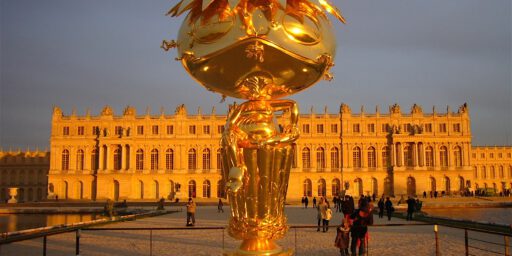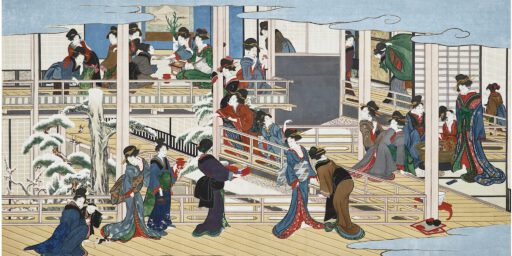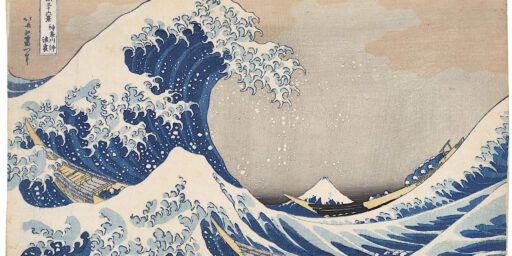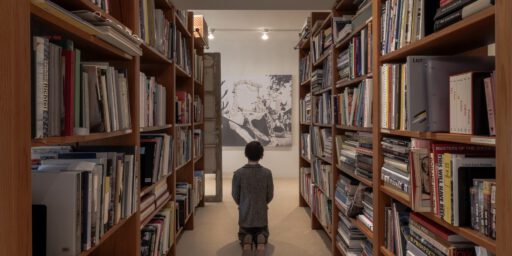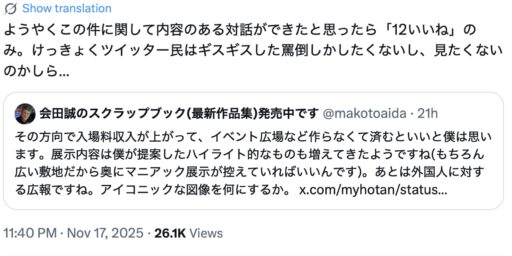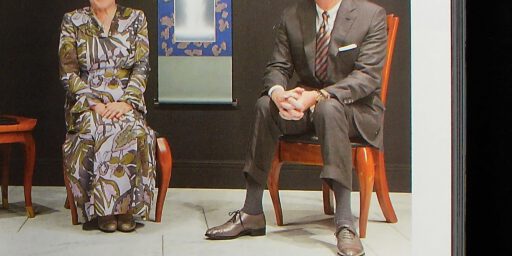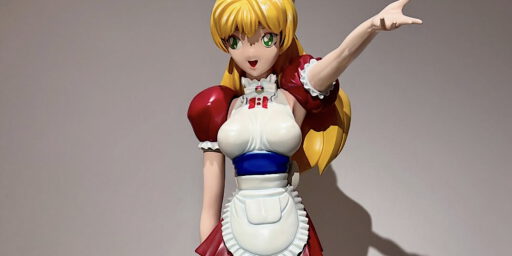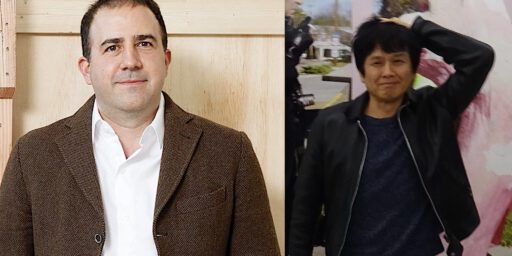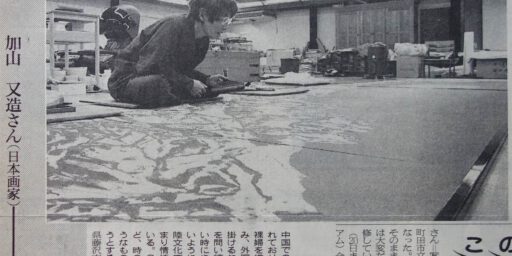美術評論家:次の絶滅危惧種? Art critics: Next endangered species?
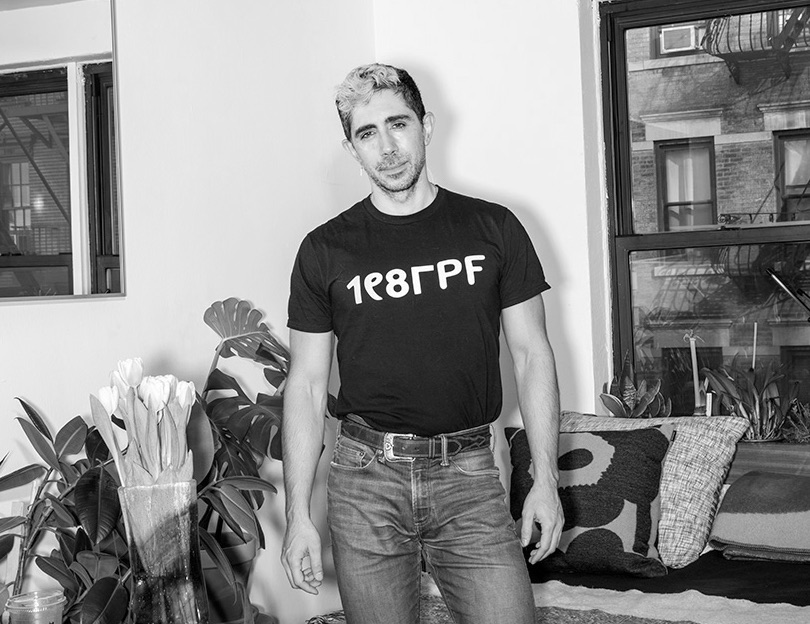
自分のアートプラクティスをフォローする方々は、私が美術評論家の市原研太郎さんをとても高く評価していることご存知ですよね。
残念ながら、アートライターと違って、本当の国際現代アートを理解した上、きちんと日本語で評論を書ける人は少ないです。日本のキュレーターたちも、海外のビエンナーレや立派な美術館の展覧会を観に行けるチャンスは少ないです。
美術評論家は、新しい芸術を一般大衆と結びつけ、その理解と鑑賞のためのプラットフォームを提供しなければならないです。また、論理的には、作品の革新に力を注ぐアーティストに批判的なフィードバックを与えた方が良いでしょう。
しかし、主流の美術評論は、ますます芸術産業の広報として利用されているだけです。これは芸術と文化に対する真の危険であり、意味のある文化として理解されるよりも、観光地として利用されることです。
アート、現代アートは、科学、哲学、政治、歴史、技術など多くの分野や学問とつながることができるため、深い知識と幅広い知識の両方が必要な活動であると言えるでしょう。
現代アートに関する深い知識と、今、何が起こっているのかを強く意識することが必要だというのが、美術評論家の仕事だと思います。
ART+CULTUREで発表している評論は、アーティストの目線で書かれてあります。やはり、新聞記者のような紹介より、ある程度、スパイシーな文章ではないと。考えさせる、ちょっと挑発的な文章ではないと、発表したくないですね。無差別的、アーティストの仲間たちに尊重され、愛され、嫌われ、拒否されないと。ダメな展覧会はだーめっ。
刺激的tiktok 【女のコの『だめ♥』ってセリフ、好きですか?】
Link_https://www.youtube.com/watch?v=W_D26IT_sCc
3,2,1 GO! DAME I TIKTOK COMPILATION だめ演技力面接
Link_https://www.youtube.com/watch?v=eDswMH5dwEo
TikTok – Dame yo !!!!
アート活動が甘く見てはいけません。平和ボケのアーティストに緊張感を与えないと、だーめっ。
最近、影響力の強いNYTimesの興味深い記事を気になりました。今日はartdailyというnewsletterも紹介されましたので、遠慮なく、全文の文章を載せますね。是非とも、deepl.comなどで、お読みになってくださいませ。
以前、米国のアート評論家たちの問題を紹介させていただきました。その延長線ですね。
Will ‘ARTnews’ and ‘Art in America’ disappear as print journals?
https://art-culture.world/articles/artnews-and-art-in-america-disappear-as-print-journals/
東京、2023年2月7日
亜 真里男
Art critics: Next endangered species?
2023, February 4
NEW YORK, NY.- Questions about the future of art criticism and how it might survive another season of layoffs and corporate mergers have dogged the International Association of Art Critics, a nonprofit organization based in Paris that represents more than 6,000 art writers worldwide including some 500 critics, art historians and scholars in the United States.
Six board members — nearly half its leadership team — have resigned in recent months from the organization’s American chapter, with most citing its failure to enact a diversity plan that members had supported since the George Floyd protests in 2020. The plan included award and fellowship opportunities for writers of color, as well as a revised mission statement reflecting the organization’s commitment to social justice.
“No aspect of that plan has been implemented yet,” critic Seph Rodney and art historian Aaron Levy wrote in a joint resignation letter sent to the board of AICA-USA in January. “All indications are that it has essentially been shelved.” They added that AICA-USA was “moribund and loyal to the time when art criticism and writing was a niche, privileged, recherché endeavor. We insist that it does not need to be this.”
The International Association of Art Critics was created in 1950 to revive cultural discourse after World War II, and it became a force in subsequent years with influential members such as Dore Ashton and John Perreault. But the organization has been weakened by decades of media cutbacks that diminished the number of art critics with staff positions on newspapers and magazines.
Chapters are responsible for vetting new members and suggesting internal policy changes, which are ultimately decided by an international committee in Paris. Seven U.S. members said that tension between conservative leaders of the group in Paris and liberal critics in the United States had thwarted progress on diversity initiatives.
“This letter of resignation raised some valid points,” Judith Stein, a writer and curator and the organization’s executive vice president, said in a phone interview, adding that “it encouraged us to reaffirm our desire to ensure that AICA-USA works better to reflect the values that it already had, which are rooted in a sincere commitment to diversity and inclusivity.”
“We are hopeful that we can bring the international committee more in line with the realities of our art world,” she added, pointing out the group’s Distinguished Critic Lecture series, which has honored many writers of color in recent years.
Over the past three years, the art world has faced a reckoning on its historical lack of diversity, while also coping with the challenges of COVID-19. And though AICA-USA hasn’t fully carried out its diversity plan, other arts sectors have taken action. For example, some museums and galleries, with bigger budgets, have hired new executive leaders; others have appointed managers to devise equity plans and strategies for increasing the diversity of the art they show or collect.
The need for change in museums was pointed out in the 2022 Burns Halperin Report, published by Artnet News in December, that analyzed more than a decade of data from more than 30 cultural institutions. It found that just 11% of acquisitions at U.S. museums were by female artists and only 2.2% were by Black American artists. (The museum study concludes with 2020, the last year for which data was available, but before the impact of changes from the Black Lives Matter movement could be felt.)
Julia Halperin, one of the study’s organizers, who recently left her position as Artnet’s executive editor, said the industry has an asymmetric approach to diversity. “The pool of artists is diversifying somewhat, but the pool of staff critics has not,” she said.
However, the matter of diversity in criticism is compounded by the fact that opportunities for all critics have been diminished.
While most editors recognize the importance of criticism in helping readers decipher contemporary art, and the multibillion-dollar industry it has created, venues for such writing are shrinking. Over the years, newspapers including The Philadelphia Inquirer and The Miami Herald have trimmed critics’ jobs. In December, the Penske Media Corp. announced that it had acquired Artforum, a contemporary art journal, and was bringing the title under the same ownership as its two competitors, ARTnews and Art in America. Its sister publication, Bookforum, was not acquired and ceased operations. Through the pandemic, other outlets have shuttered, including popular blogs run by SFMOMA and the Walker Art Center in Minneapolis as well as smaller magazines called Astra and Elephant. (National newspapers with art critics on staff include The New York Times, The Los Angeles Times, The Boston Globe and The Washington Post.)
David Velasco, editor-in-chief of Artforum, said in an interview that he hoped the magazine’s acquisition would improve the publication’s financial picture. The magazine runs nearly 700 reviews a year, Velasco said; about half of those run online and pay $50 for roughly 250 words. “Nobody I know who knows about art does it for the money,” Velasco said, “but I would love to arrive at a point where people could.”
Noah Dillon, who was on the AICA-USA board until he resigned last year, has been reluctant to recommend that anyone follow his path to become a critic. Not that they could. The graduate program in art writing that he attended at the School of Visual Arts in Manhattan also closed during the pandemic.
“It’s crazy that the ideal job nowadays is producing catalog essays for galleries, which are basically just sales pitches,” Dillon said in a phone interview. “Critical thinking about art is not valued financially.”
Large galleries — including Gagosian, Hauser & Wirth, and Pace Gallery — now produce their own publications with interviews and articles sometimes written by the same freelance critics who simultaneously moonlight as curators and marketers. Within its membership, AICA-USA has a number of writers who belong to all three categories.
Even jobs that blur the line between criticism and advertising are rarely secure. During the pandemic, Sotheby’s stopped publishing most of its glossy catalogs that appear before each auction season. The company had employed dozens of writers and editors to produce those volumes; now, it has just two editors split across New York and London.
According to Lilly Wei, a longtime AICA-USA board member who recently resigned, the group explored different ways of protecting writers in the industry. There were unrealized plans of turning the organization into a union; others hoped to create a permanent emergency fund to keep financially struggling critics afloat. She said the organization has instead canceled initiatives, including an awards program for the best exhibitions across the country.
“It just came down to not having enough money,” said Terence Trouillot, a senior editor at Frieze, an art magazine funded by the fair. He spent nearly three years on the AICA-USA board, resigning in 2022. He said initiatives to reenergize the group “were just moving too slowly.”
The organization has yearly dues of $115 and provides free access to many museums. But some members complained that the fee was too expensive for young critics, yet not enough to support significant programming. So leaders behind the diversity action plan were frustrated when AICA-USA hired an outside consultant, Buff Kavelman, to review their work.
“It felt like a feet-dragging exercise,” said Rodney (he is also a New York Times contributor).
Efforts to revive AICA-USA are continuing. In January, Jasmine Amussen joined the organization’s board to help rethink the meaning of criticism for a younger generation.
Amussen, 33, is the editor of Burnaway, which focuses on criticism in the American South and often features young Black artists. (The magazine started in 2008 in response to layoffs at the Atlanta Journal-Constitution’s culture section and now runs as a nonprofit with four full-time employees and a budget that mostly consists of grants.)
Amussen said the nonprofit model has allowed Burnaway to experiment with art criticism through summer writing boot camps and a recruitment effort to bring untraditional writers into the magazine’s digital pages. Recent contributors included a landscape architect, a rap scholar and a comic illustrator. Widening the appeal of arts writing is the goal.
“I’m in the art world because there is no other option for strange people who want to write about cultural things,” Amussen said in a phone interview. “And I worry that if something isn’t done to remind people why art and criticism are important, then the industry won’t survive.”
https://artdaily.cc/news/154262/Art-critics–Next-endangered-species-#.Y-JDei0RoWo
Original:
https://www.nytimes.com/2023/02/04/arts/design/art-writers-aica-rift-diversity-jobs.html
—–
Up-date 2023/10/27
Artforum fires top editor after its open letter on Israel-Hamas war

NEW YORK, NY.- One of the art world’s top magazine editors was fired Thursday night after the publishers of Artforum said the staff’s decision to post an open letter about the Israel-Hamas war failed to meet the organization’s standards.
The editor-in-chief, David Velasco, said he had been terminated after six years as Artforum’s leader. He had worked at the publication, considered among the world’s most prestigious art magazines, since 2005.
“I have no regrets,” Velasco said in an email. “I’m disappointed that a magazine that has always stood for freedom of speech and the voices of artists has bent to outside pressure.”
Thousands of artists, academics and cultural workers, including Velasco, signed the Oct. 19 open letter, which supported Palestinian liberation and criticized the silence of cultural institutions about the Israeli bombing of residents in Gaza.
The letter initially omitted mention of Hamas’ surprise Oct. 7 attack, which killed more than 1,400 Israelis, information that was added after criticism from subscribers and advertisers. A preface was also added to say that the letter “reflects the views of the undersigned individual parties and was not composed, directed or initiated by Artforum or its staff.”
It is not clear who wrote the letter. In it, the signatories “call for an end to the killing and harming of all civilians, an immediate cease-fire, the passage of humanitarian aid into Gaza, and the end of the complicity of our governing bodies in grave human rights violations and war crimes.”
The magazine’s publishers, Danielle McConnell and Kate Koza, did not immediately respond to a request for comment. In a post on the magazine’s website Thursday evening, they criticized the decision as “not consistent with Artforum’s editorial process.” The letter “was widely misinterpreted as a statement from the magazine about highly sensitive and complex geopolitical circumstances,” they said in the post, which made no mention of Velasco’s termination.
“Our publication has a proud history of advocacy,” they added. “That the letter was misinterpreted as being reflective of the magazine’s position understandably led to significant dismay among our readers and community, which we deeply regret.”
The Oct. 19 open letter met condemnation, drawing responses by figures in the art world. On WhatsApp, campaigns were organized to dissuade advertisers from working with the magazine.
“I think it was a complete betrayal of their readers,” Michael Phillips Moskowitz, a curator and collector, said. “It was characterized by hubris with no understanding of what led to this moment.”
Several prominent artists later removed their names from the Oct. 19 letter, but it remained popular among many of the people who signed it, including those who said that the intention was to advocate peace.
“Tampering with the opinions of artists is to not understand the role of art,” said Cecilia Vicuña, a Chilean poet and artist who signed the letter, adding that she valued “the right to freedom of speech.”
Velasco joined Artforum in 2005 as an editorial assistant and became editor-in-chief in 2017 when the magazine’s leadership was accused of ignoring issues of misconduct amid a sexual harassment lawsuit against its publisher at the time, Knight Landesman. The lawsuit was later dismissed, but Velasco had to rebuild trust in the publication’s brand. He was largely successful, restoring Artforum’s reputation as an authoritative source of art world intrigue and criticism.
Before Velasco was fired, some artists defended him in a letter to Jay Penske, the mogul behind Penske Media Corp., which recently acquired Artforum, saying that Velasco had “established a fearless and uncompromising vision for the magazine.”
“David’s leadership at Artforum is needed now more than ever,” the letter said.
This article originally appeared in The New York Times.
…..
NEWS
A STATEMENT FROM ARTFORUM’S PUBLISHERS
By News Desk
October 26, 2023 7:40 pm
On Thursday, October 19, an open letter regarding the crisis in the Middle East was shared on Artforum’s website and social platforms without our, or the requisite senior members of the editorial team’s, prior knowledge. This was not consistent with Artforum’s editorial process. Had the appropriate members of the editorial team been consulted, the letter would have been presented as a news item with the relevant context.
The open letter was widely misinterpreted as a statement from the magazine about highly sensitive and complex geopolitical circumstances. While a meaningful expression of advocacy from a large group of people in our community, the letter as it appeared on our platforms lacked the necessary context to make clear that it originated from outside the magazine.
Our publication has a proud history of advocacy. That the letter was misinterpreted as being reflective of the magazine’s position understandably led to significant dismay among our readers and community, which we deeply regret. It also put members of our team in the untenable position of being represented by a statement that was not uniformly theirs.
We want to make clear that we unequivocally condemn the atrocities committed by Hamas on October 7, and we are distraught at the immense destruction and suffering of the civilians in Gaza.
We understand our responsibility in our approach to complex conversations, and remain committed to upholding Artforum’s legacy of providing a platform that encourages thoughtful cultural dialogue, conversation, and debate.
—Danielle McConnell and Kate Koza
https://www.artforum.com/news/a-statement-from-artforum-s-publishers-518836/
Up-date 2023/10/29
Several Artforum Editors Resign Following Firing of David Velasco Over Gaza Letter
Four Artforum staffers have resigned after David Velasco, the publication’s former editor, was fired this week.
On Friday, Kate Sutton, an associate editor at Artforum since 2018, announced on X that she had officially resigned. On Saturday, Zack Hatfield and Chloe Wyma, both of whom were senior editors at Artforum, also announced that they had resigned. ARTnews has also learned that Emily LaBarge, a London-based contributor who edited international reviews, has severed ties with Artforum.
“The firing of David Velasco violates everything I had cherished about the magazine and makes my work there untenable,” Wyma wrote on X.
Meanwhile, prominent artists Nan Goldin and Nicole Eisenman told the New York Times that they would no longer work with Artforum, with Goldin describing the current environment as the most “chilling period” she’s ever lived through.
Velasco’s firing came after Artforum published an open letter calling for a ceasefire in Gaza on October 19. The letter, signed by thousands of artists, also appeared in e-flux and Hyperallergic, and had circulated as a Google document before it was published on those websites and Artforum. Velasco, along with several other members of Artforum’s staff, signed the letter, although it is still unclear who initially wrote it.
“We support Palestinian liberation and call for an end to the killing and harming of all civilians, an immediate ceasefire, the passage of humanitarian aid into Gaza, and the end of the complicity of our governing bodies in grave human rights violations and war crimes,” the letter published on Artforum reads.
After the letter was published, it became the subject of blowback, with dealers Dominique Lévy, Brett Gorvy, and Amalia Dayan writing a statement on Artforum in which they condemned it for failing to mention the Hamas attack on October 7 that killed 1,400 Israelis and involved the taking of 200 hostages.
Another letter signed by major dealers and artists also began to circulate; its subject was an “uninformed letter” in an unnamed publication, and it made a call for “empathy” after the Hamas attack. That second letter did not mention the thousands of Gazans who have been killed by Israeli airstrikes, as reported by the local health ministry.
As pressure mounted, Artforum’s letter continued to shift, with added texts mentioning “revulsion” over the Hamas attack and a preface that the letter “was not composed, directed, or initiated by Artforum or its staff.” Some names also dropped from the signatories.
Artforum publishers Danielle McConnell and Kate Koza put a post on the Artforum website earlier this week saying that the letter was posted to the site and to social media “without our, or the requisite senior members of the editorial team’s, prior knowledge,” and that doing so was “not consistent with Artforum’s editorial process.”
After he was fired, Velasco, who became editor in 2017, told the Times, “I have no regrets. I’m disappointed that a magazine that has always stood for freedom of speech and the voices of artists has bent to outside pressure.”
Penske Media Corporation, which owns both ARTnews and Artforum, did not respond to a request for a comment.
https://www.artnews.com/art-news/news/david-velasco-artforum-editors-resign-1234685075/
Up-date 2023/10/30
Artists call for boycott after Artforum fires its top editor
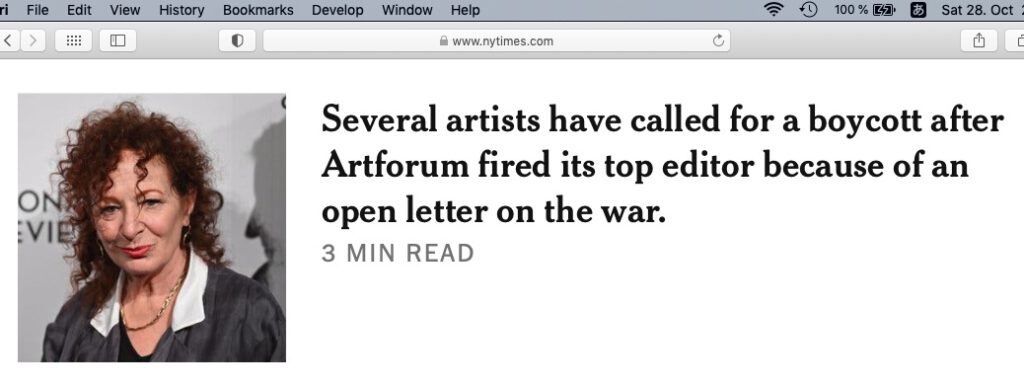
NEW YORK, NY.- One day after Artforum magazine fired its top editor, David Velasco, because of an open letter it published about the Israel-Hamas war, another editor resigned and several prominent artists said they would boycott the publication unless Velasco was reinstated.
Divisions over how to discuss the conflict in the Middle East have frayed yearslong relationships between collectors and artists. On Friday, Nicole Eisenman and Nan Goldin criticized the magazine’s owner for terminating Velasco, who had been its editor-in-chief for six years, and said they would no longer work with Artforum.
“I have never lived through a more chilling period,” said Goldin, who is one of the most celebrated living photographers and signed the open letter that called for Palestinian liberation and a cease-fire. “People are being blacklisted. People are losing their jobs.”
Nearly 50 Artforum employees and contributors have signed a different letter demanding that Velasco be reinstated, saying his termination “not only carries chilling implications for Artforum’s editorial independence but disaffirms the very mission of the magazine: to provide a forum for multiple perspectives and cultural debate.”
There was a backlash among some readers after the magazine published an open letter on Oct. 19 that did not initially mention the attack by Hamas that killed more than 1,400 Israelis.
A sudden campaign of letters denounced the thousands of artists and cultural workers, including Velasco, who had signed the letter. Gallerists urged people to remove their names from the letter, and several collectors asked the Wexner Center for the Arts at Ohio State University to shut down an exhibition of Jumana Manna, a Palestinian artist who signed the open letter. (A museum spokesperson said it would continue to exhibit Manna’s work; she confirmed that the show was still on.)
Artforum distanced itself from the open letter after receiving pressure from advertisers. The magazine’s publishers later released a statement that said the post was “not consistent with Artforum’s editorial process,” adding that it was “widely misinterpreted as a statement from the magazine about highly sensitive and complex geopolitical circumstances.”
Penske Media Corp., which owns Artforum, did not respond to a request for comment.
At least one editor resigned from Artforum after its decision to fire Velasco: Kate Sutton, who had been an associate editor since 2018, said she was “absolutely gutted” and was “not sure I can see a way forward for the magazine.”
More than a dozen artists told The New York Times that threats of reprisal from collectors made it difficult to publicly defend their decision to sign the open letter, emphasizing that their intention was to call for peace.
“Collectors are always, in one way or another, making a big deal out of something an artist signed,” said Eisenman, an artist who has exhibited with institutions including the Whitney Museum of American Art and the Cleveland Museum of Art. “But it is still surprising to learn how many collectors believe that owning a few drawings of mine means they get to tell me what to do with my name.”
She added: “I want to echo what activists have been yelling in the streets: Not in my name. This war will not be done in my name. I resent these cowardly bullying and blackmail campaigns to distract everyone in the art world from the central demand of the letter, which was: cease-fire!”
Some collectors tried to persuade artists to retract their signatures. Others in the art world threatened to voice their concerns by selling works from those who signed the letter.
“We have a de-accession plan” that would “diminish the artists’ status,” Sarah Lehat Blumenstein, who fundraises for a major museum, wrote to members of a WhatsApp group organized as a response to the open letter.
In a phone interview, Blumenstein, who is Jewish, said that such a plan was not active and that her efforts to hold artists accountable came from a fear that rising antisemitism was endangering her right to exist.
Goldin said people had incorrectly conflated antisemitism with supporting Palestinians.
“Whatever position we took was our right to free speech,” she said. “I have no plans to work with Artforum because they fired someone for whom I have enormous respect.”
This article originally appeared in The New York Times.
https://artdaily.cc/news/163568/Artists-call-for-boycott-after-Artforum-fires-its-top-editor
Update: 2023/12/9
Bruised by war-related boycott, Artforum seeks a reset
NEW YORK, NY.- A skeleton crew of editors needed to take a hacksaw through the December issue of Artforum magazine. There were only a few weeks between the sudden firing of its editor-in-chief and a print deadline for the glossy’s annual “Year in Review” issue.
The fallout had been swift when Artforum’s owner fired the editor, David Velasco, after the magazine published an open letter about the Israel-Hamas war that supported Palestinian liberation and initially omitted mention of the victims of the Hamas attack on Oct. 7.
At least six members of the editorial team resigned and nearly 600 writers signed letters boycotting the magazine and its sister publications, including ARTnews and Art in America. Regular contributors such as critic Jennifer Krasinski and art historian Claire Bishop requested to have their articles pulled from the December issue. Others such as filmmaker John Waters, curator Meg Onli and artist Gordon Hall also withdrew their writing.
The “Year in Review” issue that has begun arriving to subscribers is a week later than usual and noticeably slimmer. At 150 pages of articles and advertisements, it is about one-third smaller than last December’s 224-page issue.
“There is a before and there is an after in the art world,” said art historian Julia Bryan-Wilson, who wrote last month’s cover story on artist Sam Gilliam and said she would no longer contribute to Artforum. “That is how stark the discourse feels after the magazine fired David.”
Hall said the firing was an astonishing betrayal of the art world’s values.
“We may disagree or misunderstand each other,” Hall said, “but we collectively value the ability to express ourselves without risking professional punishment, silencing or shunning.”
As the art world continues to splinter over questions of how to equitably address Israeli and Palestinian suffering, Artforum, which has about 30,000 print subscribers and gets about 8.3 million page views annually, is attempting to hit the reset button.
“We have lost a number of valued colleagues whose talents have been made manifest in our pages and platforms,” publishers Danielle McConnell and Kate Koza wrote in a note in the December issue. “We have been given reason to reflect on and confront Artforum’s role in times of humanitarian crisis.”
Jay Penske, CEO of Penske Media, which owns the magazine and others including Rolling Stone and Variety, also published a statement in the issue, saying that Velasco’s departure had been misinterpreted as the suppression of speech.
“Artforum has a proud history of advocacy and is a platform that inspires debate and discourse,” Penske wrote. “This will never cease under our ownership.”
To Velasco, Artforum’s response is lacking. “Penske Media is underestimating Artforum’s readership if they think these nonexplanations will restore faith in the magazine’s credibility,” Velasco said.
Established in 1962, Artforum became a mouthpiece for the intellectuals who shaped American postwar art into a cultural force. The magazine’s direction shifted as its editorial leadership did, but it typically hired artists for exclusive projects and supplemented its subscriber income with advertisements from the galleries reviewed in its pages.
Velasco, who joined the magazine nearly two decades ago, assumed the top leadership role in 2017 with a plan to restore its reputation after its longtime publisher, Knight Landesman, was accused of sexual harassment. As part of that effort, Artforum published essays that helped signal the art world’s shifting relationship with its patrons.
A 2018 project by photographer Nan Goldin highlighted the role of the Sackler family in the opioid epidemic, which has resulted in the family’s name being wiped from museum galleries around the world. A year later, an essay by writers Hannah Black, Tobi Haslett and Ciarán Finlayson described the 2019 Whitney Biennial as “The Tear Gas Biennial” because of a trustee’s relationship with the defense industry. That trustee, Warren Kanders, later resigned from the museum board.
But the open letter that Artforum published about the Israel-Hamas war on Oct. 19, which called for an immediate cease-fire, resulted in significant blowback for the magazine itself. Some large galleries, including David Zwirner, said they would pull advertisements from the publication, and other groups such as the Chanel culture fund threatened to withdraw their support, according to four magazine employees.
The letter, which Velasco signed, originated with nearly a dozen artists and scholars primarily based in Britain.
Accusations of censorship in the art world have continued, with curators and artists saying that they have lost jobs and exhibitions for supporting Palestinian causes.
Indigenous curator Wanda Nanibush left her position at the Art Gallery of Ontario after outside activists accused her of “posting inflammatory, inaccurate rants against Israel.”
Artist Candice Breitz had an exhibition canceled in Germany, where officials at the Saarland Museum in Saarbrücken said they would not show works by anyone “who does not clearly recognize Hamas’ terror as a rupture of civilization.” Breitz, who is Jewish and has criticized Israel on social media, said she had condemned Hamas’ actions “loudly and unequivocally.”
And the entire selection panel charged with finding the next curator of Documenta, a global exhibition of art scheduled for 2027, resigned after disputes with administrators related to the Israel-Hamas war.
Bishop said free speech was being stifled in the art world, pointing to the response to the open letter in Artforum.
“This letter — which has been followed by countless others — is like a head on a pike, standing as a warning to other art workers who might dare to criticize Israel,” she said.
The disagreement about who is to blame in the Artforum controversy has extended outside the magazine’s pages. It has been cited at pro-Palestinian protests throughout New York, which have targeted the American Museum of Natural History and the New York Public Library at Bryant Park, where officials said that demonstrators caused nearly $75,000 worth of damage to its facade.
This week, gallerists Dominique Lévy, Brett Gorvy and Amalia Dayan said their storefront was vandalized with a fake apology by the dealers, who had published a response condemning the Artforum open letter “for its one-sided view.”
After Penske Media acquired Artforum last year, it had plans to further monetize the publication’s reputation. Four former employees said the company was planning events to coincide with major art fairs such as Frieze New York, where editors would lead gallery tours. There was also a discussion about selecting an artist to design the crystal ball that drops in Times Square during the New Year’s Eve celebration run by Penske Media. (A spokesperson for Penske Media said there were not plans for such events.)
But the magazine’s future is now in flux.
A majority of the authors featured in November’s issue are still boycotting Artforum. The masthead in the December issue includes at least one researcher who had resigned before publication.
https://artdaily.cc/news/164772/Bruised-by-war-related-boycott–Artforum-seeks-a-reset
